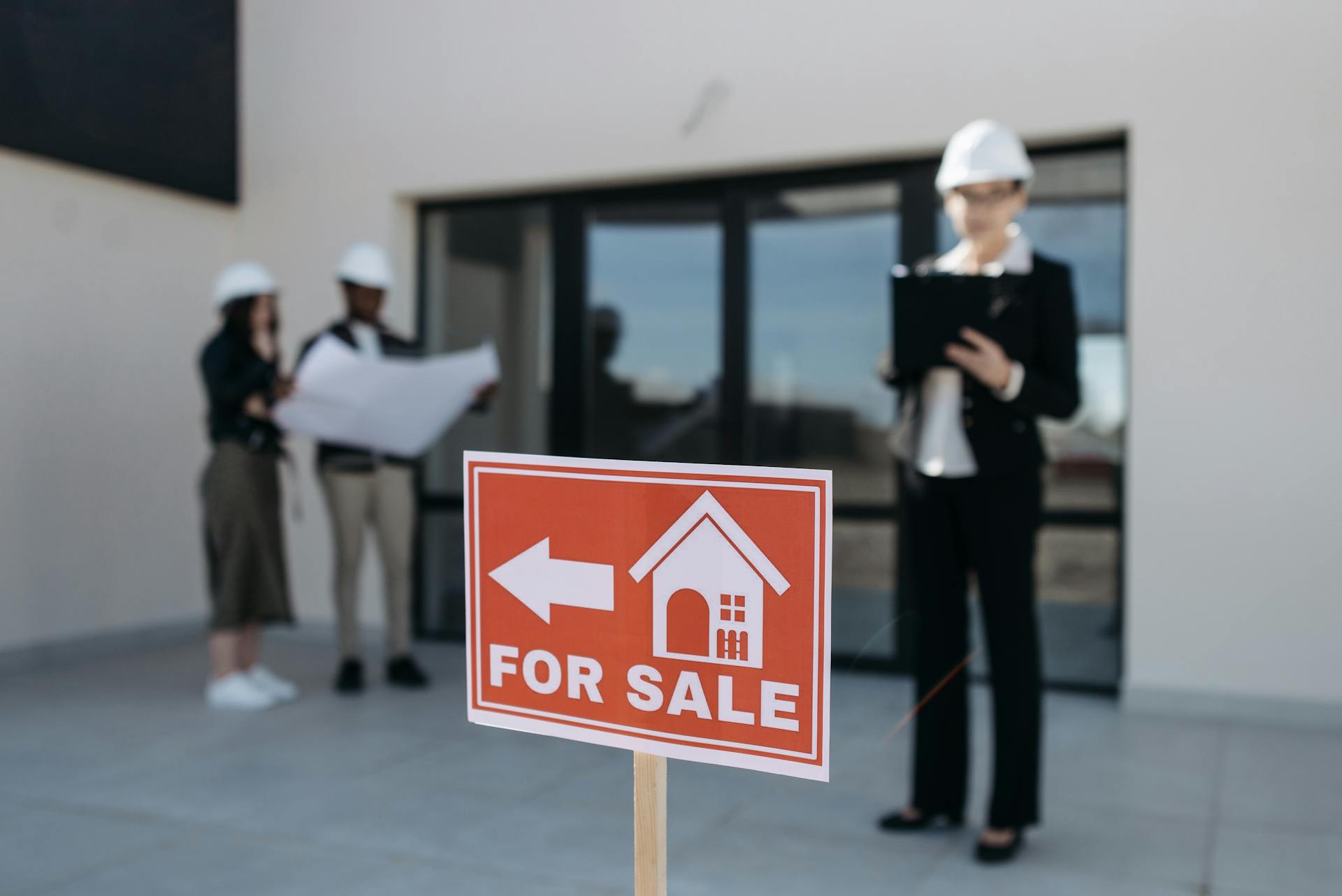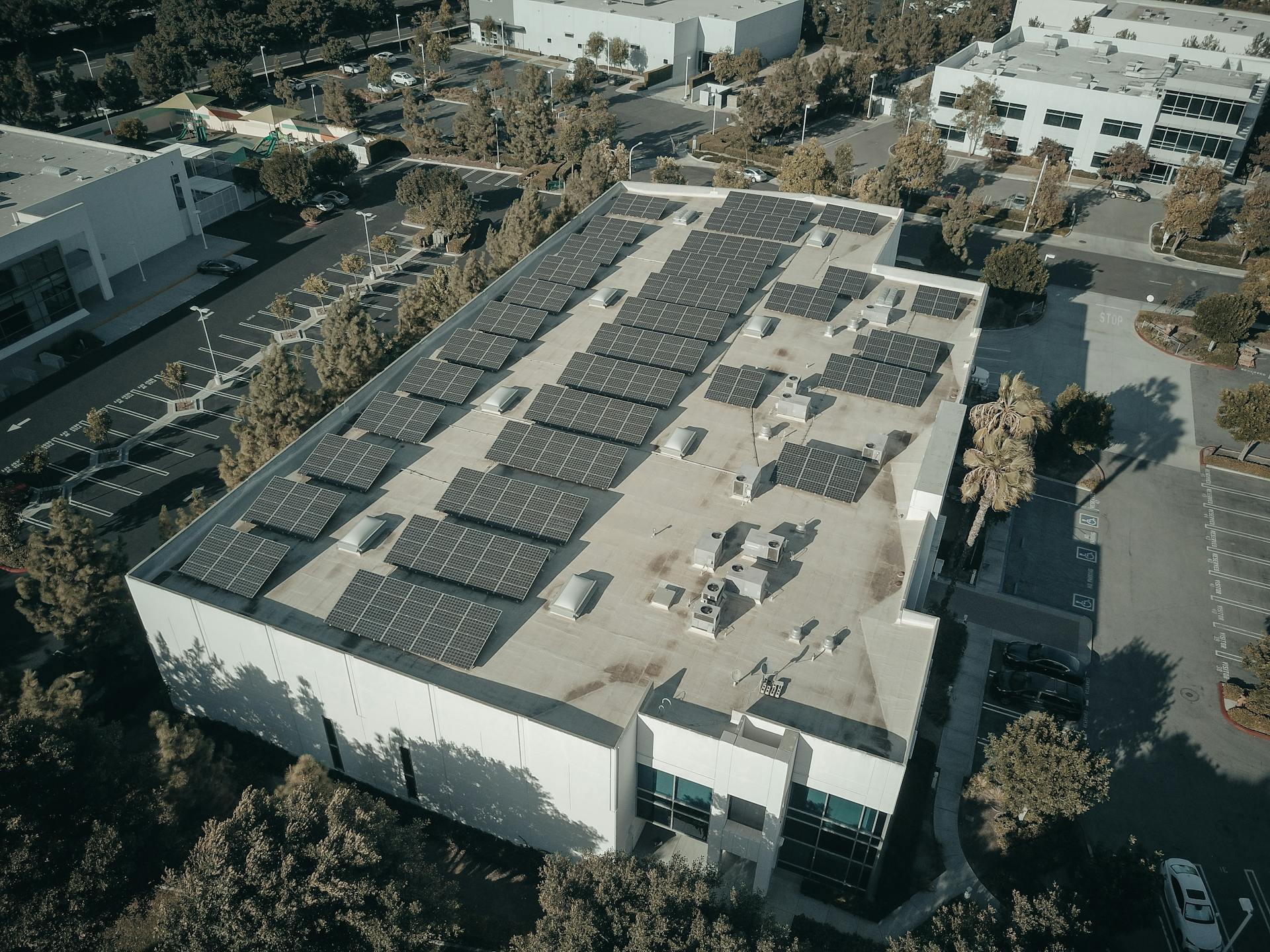
In Texas, commercial real estate loans can be obtained through various financing options.
The most common types of commercial real estate loans in Texas are conventional loans, SBA loans, and hard money loans.
Conventional loans are ideal for investors with good credit and a significant down payment.
SBA loans offer favorable terms, such as lower interest rates and longer repayment periods.
Hard money loans are short-term, high-interest loans typically used for fix-and-flip projects or properties that need renovation.
Commercial real estate loan rates in Texas can range from 4% to 12% APR, depending on the lender and loan terms.
Lenders in Texas often require a minimum credit score of 650 for commercial real estate loans.
The Texas Department of Savings and Mortgage Lending regulates commercial real estate lending in the state.
Commercial real estate loan terms can vary from 5 to 25 years, depending on the loan type and lender.
You might like: Car Payment Terms
Types of Commercial Real Estate Loans
Commercial real estate loans in Texas come in a variety of forms to suit different needs. A Permanent Loan is a first mortgage on a commercial property with a term of at least five years. Commercial Mortgage Loans are secured by business or investment properties and typically require a personal guarantee.
Commercial Mortgage Loans can have loan terms ranging from one year to 30 years with rates starting from 4% to 12%. Conduit Loans, also known as CMBS loans, are used for properties such as retail buildings, warehouses, and hotels. They have fixed interest rates and balloon payments at the end of the loan term.
SBA Loans are guaranteed by the Small Business Administration and come in different types, including the 7(a) loan, which funds the full business loan. The SBA 7(a) loan can be used for various expenses, such as working capital, equipment, and property purchases.
Bridge Loans provide short-term financing for commercial properties, typically with a six-month to three-year term. They are often obtained when a borrower is waiting for longer-term financing or attempting to refinance an existing obligation.
Commercial mortgage lenders in Texas typically lend up to 75-80% on an apartment purchase and up to 70-75% on other types of commercial property. Owner-occupied business real estate, however, may qualify for up to 90% LTV financing.
Expand your knowledge: Commercial Loans for Rental Properties
Commercial Real Estate Loan Options in Texas
Commercial real estate loan options in Texas are diverse and can be tailored to suit specific needs. Commercial mortgage lenders typically lend up to 75-80% on an apartment purchase, while other types of commercial property may receive up to 70-75% loan-to-value financing.
For investment properties, lenders offer a range of mortgage products, including Conventional, CMBS/Conduit, Insurance, and Agency (FHA/HUD and USDA) options. These mortgages can be used for office, retail, industrial/warehouse, self-storage, and other types of commercial properties.
Owner-occupied commercial properties, where the owner occupies at least 50% of the premises, can also qualify for various mortgage options, including Conventional, Insurance, and Agency programs.
Suggestion: Owner Financing in Real Estate
Owner Occupied Mortgages
Owner Occupied Mortgages can be a great option for business owners in Texas who also occupy their commercial properties.
Commercial properties that meet the 50% occupancy requirement, such as office spaces or retail stores, qualify for Owner Occupied Mortgages.
Types of mortgages available for owner-occupied buildings include Conventional, Insurance, and Agency programs.
FHA / HUD, SBA, and USDA Agency programs are also options for Owner Occupied Mortgages.
Construction mortgages are available on a case-by-case basis to develop or reposition a property for the owner's use.
Take a look at this: Non Owner Occupied Mortgage Loans
Mortgage Benefits
Commercial mortgage rates in Texas can start as low as 5.62% (as of January 4th, 2025). This is a great opportunity for business owners and investors to secure funding for their commercial properties.
A commercial mortgage broker with over 30 years of lending experience can guide you through the process. They can help you find the best rates and terms for your specific needs.
No upfront application or processing fees are required, making it a cost-effective option. The simplified application process also saves you time and hassle.
You can get up to 80% LTV on multi-family properties, 75% on commercial properties, and 90% with SBA financing. This means you can keep more of your hard-earned money and invest it elsewhere.
Terms and amortizations can go up to 30 years, giving you flexibility in your repayment schedule. Loans are available for purchase and refinance, including cash-out options.
Getting a firm loan approval requires providing personal financial statements, property information, and credit scores. This ensures lenders understand your financial condition and the property's fundamentals.
A unique perspective: Terms for Commercial Real Estate Loans
Commercial mortgage rates are determined by various factors, including property type, location, loan-to-value ratio, and credit rating. The riskier the loan, the higher the interest rate.
Unlike residential loans, commercial mortgage lenders consider the property's rent roll, operating statements, and other factors to determine the cash flow potential. This approach makes commercial mortgage loans more nuanced than residential loans.
Most commercial mortgage loans are fixed for 5, 7, or 10 years, with a 25-30 year amortization schedule. Loans can be recourse or non-recourse, depending on your lender's requirements.
Typically, commercial mortgage lenders lend up to 75-80% on apartment purchases, requiring a 20-25% down payment. For other commercial properties, the down payment is usually 25-30%.
For more insights, see: Non Recourse Commercial Real Estate Loans
Commercial Real Estate Loan Process
The commercial real estate loan process in Texas is a multi-step journey that requires careful planning and preparation. A commercial real estate loan typically requires a down payment of 20-30%.
To qualify for a commercial real estate loan, borrowers must have a minimum credit score of 680, as stated in the article. This is a crucial factor in determining the interest rate and loan terms.
The loan application process usually takes 30-60 days, depending on the complexity of the loan and the lender's workload. Borrowers should be prepared to provide extensive financial documentation during this time.
Commercial real estate loans in Texas can be secured or unsecured, with secured loans typically having a lower interest rate and better loan terms. Unsecured loans, on the other hand, may have higher interest rates and stricter repayment terms.
Requirements
To secure a commercial real estate loan, you'll need to meet the lender's requirements. A minimum credit score of 650 is often required, but this can vary depending on the lender and the project's risk level.
Lenders typically require a down payment of 20-30% of the loan amount, but some may accept lower down payments with higher interest rates.
A solid business plan is essential to demonstrate a clear understanding of the project's financials and potential for growth. This plan should outline projected income, expenses, and cash flow.
Commercial property valuations are often based on the property's gross income multiplier, which can range from 100 to 300, depending on factors such as location and property type.
On a similar theme: Low down Payment Commercial Loans
Repayment Schedules
Understanding your commercial real estate loan repayment schedule is crucial to making informed decisions about your business finances.
Your monthly payment will consist of the principal, interest, and fees, which you'll pay in a set amount each month.
The total of all loan payments due includes the principal amount borrowed, plus interest and fees.
You can save money on interest by repaying the loan early.
The annual percentage rate (APR) shows the loan's true yearly cost, making it easier to compare different loan options.
Your APR is determined by your credit score and the financials of your company, including annual revenue and time in operation.
Readers also liked: Jumbo Loan Amount Texas
Origin
Origin Bank is a commercial lender that serves Texas, Louisiana, and Mississippi. They have a strong presence in the community, which is reflected in their values.
Origin Bank is active in various sectors, including self-storage, student housing, townhome construction, medical office, and manufactured housing.
Readers also liked: Commercial Bank
Commercial Real Estate Loan Rates and Fees
Commercial real estate loan rates and fees can be complex, but understanding the basics can help you navigate the process. Commercial real estate loan interest rates and fees are typically more expensive than residential loans.
Typical down payments range from 20% to 30% of the total buying price. Commercial loan rates are also generally higher than residential loans, ranging from 10% to 20% for most borrowers.
Loans backed by the Small Business Administration (SBA) are among the most affordable in the market, with commercial mortgage rates ranging from 7.75 percent to 10.25 percent. These rates are determined by the U.S. Treasury Bonds, which establish the upper limits for real estate loan charges.
Some Texas commercial mortgage rates include:
- Multifamily: 5.62%
- Commercial Real Estate Loan: 6.98%
- Single Tenant Lease: 6.68%
- Business Real Estate Loan: 6.88%
These rates vary depending on the loan product, location, and other factors. Commercial mortgage lenders tie their commercial loans to an index, such as the prime rate and LIBOR, which measures the rate of change in market securities.
Readers also liked: Current Prime Rate for Commercial Loans
Here's a breakdown of some common commercial loan types and their average rates in Texas:
Frequently Asked Questions
How much money do you need for a commercial real estate loan?
For a commercial real estate loan, you'll typically need a down payment of 20% to 40% of the purchase price, though this can vary depending on the property type and other factors. Learn more about the specific requirements for your commercial property loan.
What banks hold the most commercial real estate loans?
Banks with significant commercial real estate loan portfolios include JP Morgan, Wells Fargo, Bank of America, U.S. Bank, and PNC Bank, collectively holding over $500 billion in loans. These major financial institutions are at the forefront of the commercial real estate market's potential financial reckoning.
Sources
- https://hubcitylending.com/services/commercial-real-estate-financing/
- https://www.lev.co/blog/best-texas-commercial-real-estate-lenders
- https://www.texasgulfbank.com/blog/how-to-apply-for-a-commercial-real-estate-loan-in-texas/
- https://selectcommercial.com/texas-commercial-mortgage.php
- https://www.commercialloandirect.com/commercial-loans/texas
Featured Images: pexels.com


